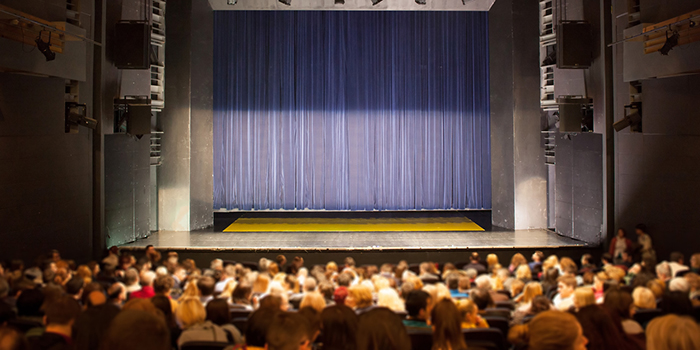What goes through your mind when you hear the term “stage presence”? Do you think of standup comedians – Jerry Seinfeld, Dave Chappelle, Robin Williams? Maybe you think of Broadway stars. Or perhaps your mind turns to musicians who know how to command a crowd and put on an incredible show.
You’d be right in thinking of these people as having great stage presence. Here’s something to consider, though: stage presence is something everyone should have. That’s because, regardless of whether you ever perform on the Broadway stage, you’ll undoubtedly be called to the stage of giving a presentation.
For that reason, stage presence is an indispensable communication skill that everyone should have.
What We Mean By Stage Presence
Before we get into discussing how you can develop your own stage presence, let’s start with a review of our term. What exactly do we mean by “stage presence”?
For our purposes, stage presence means connecting with your audience in a way that makes them want to watch you and listen to you.
Taken in this way, you can see that stage presence has a vast application outside of celebrity performances. Everyone will have an audience at various points in their careers, and connecting with your own audience to communicate well is an integral part of success in any context. In fact, as we’ve mentioned before, the majority of high-earning executives rank communication skills as the most important factor towards their success.
The Myth of Stage Presence
Many people acknowledge the importance of stage presence but have resigned themselves to the idea that it’s unobtainable if it doesn’t come naturally to them. After all, the great speakers and performers are born with great stage presence, right?
Actually, that’s not the case at all. While it’s obviously true that some people are more naturally inclined to have stage presence, it’s important to understand that stage presence is a skill. And, just like any other skill, it can be learned and improved.
Tips to Improve Your Stage Presence
So, are you ready to improve your stage presence? Here are a few tips to help you start connecting with your audience during presentations.
1. Be Bigger Than Your Everyday Demeanor
This may be the most important component of stage presence: you need to step onto the stage with the mindset that you will be bigger than your everyday demeanor.
Think again of the people who have great stage presence. Do you think these performers are the same off the stage as they are on it? Of course they aren’t. When Robin Williams was on stage, he was making a concerted effort to entertain. Performers approach performances with an enthusiasm and energy that isn’t ordinary. You should do the same.
The mindset, to borrow a term from the world of theater, could be called opening night enthusiasm. The term is fairly self-explanatory; by the second week matinee showing of a play, it’s hard for the actors to maintain energy. But it’s the cast’s job to perform with the same energy, enthusiasm, and connection to the audience every show.
Stage presence takes effort.
Remember, you can’t be invisible and present simultaneously. While you may not be someone who loves making presentations, presentations are critical to your career growth. You can make a concerted effort to step out of your comfort zone, project energy, and connect with your audience.
The right mindset is the first step.
2. Keep Your Message Fresh
So, you have the mindset of a performer. Now, you need to work to keep your information interesting and your message fresh.
Remember, even the best actors in the world can’t make a terrible script entertaining. A good stage presence requires that the presenter have good, fresh material. It’s obvious to the audience when there is nothing of the speaker in the presentation – when all that the speaker is doing is reading information from PowerPoint slides.
Presenting a boring message is a surefire way to minimize stage presence. To avoid that, we recommend incorporating what we call “sparklers” into your presentation.
Sparklers are things that you sprinkle into your presentation to keep it interesting. They’re statistics, stories, anecdotes, analogies, and maybe even candy handouts. They’re the pieces of your presentation that your audience will sit up and pay attention to.
If you can keep your audience’s attention, you’re likely connecting well. And, per our definition, that means you’re on your way to having stage presence.
3. Convey Physical Confidence
For many people, the term stage presence connotes an actual physical posture. While a physical confidence often follows mindset and message, it’s also helpful to focus on how you can intentionally convey this. Your physical stance does influence the audience’s perception of you as a speaker.
Let’s take a look at some common stances that carry unwanted connotations. Then, we’ll show you the most common and effective stance for presenting with stage presence.
The Fig Leaf Position

This stance can convey weakness and timidity.
Hands Clasped Behind Back

This stance can convey weakness, as well.
Both Hands in Pockets

In most contexts, this stance conveys too much casualness.
Clasping Upper Arm

This stance also conveys weakness and timidity.
Arms Crossed in Front

This stance conveys that the speaker is guarded.
The Best Position: Flat Stance, Arms at Sides

This stance suggests openness and confidence. When presenting, assume this stance, and don’t shift your weight, cock your hip, or lean on one leg more than the other. Doing so detracts from your authority.
It’s also appropriate to make natural gestures that are in accordance with your message. As you gesture, make sure to keep your motions above the waist, but not in front of your own face. You want your audience to be able to view both your face and your gestures simultaneously.
Finally, if you’re presenting from a seated position, you’ll want to sit in front of your PowerPoint slides. You are the focal point of the presentation – not your slides. Clasp your hands in front of you and lean in slightly while speaking. This conveys confidence and enthusiasm.
4. Practice to Have Stage Presence
Lastly, stage presence takes practice.
Think of your favorite TV show – maybe it’s The Big Bang Theory. It seems so naturally funny, right? And yes, there is a great script, the actors have great timing, and they deliver their lines well. But guess what? It all starts with the cast doing a simple read-through together. Without practicing the performance until the actors are comfortable with their lines, there would be no stage presence.
The final product only seems natural because of the hours of practice that went into it.
Before giving a speech, you should practice it out loud at least three times. Once you’ve gotten it to the point where you don’t sound stilted, start to incorporate your enthusiasm for the subject into your delivery. Get excited about your message, and be animated and confident.
You Can Have Stage Presence
Stage presence isn’t just for celebrity performers. We’re all called to present in some context, and that means that stage presence is essential for everyone. You don’t have to be a Broadway star or a used car salesman, but you do need to entertain your audience to communicate a message that they’ll remember.
These tips will get you started. To develop your stage presence fully, we recommend presentation training. Remember, the more you practice the skills and techniques of presenting, the better stage presence you’ll have.
At The Ammerman Experience, we’ve been helping our clients develop stage presence and other essential communication skills for over 40 years. To learn how we can help you, get in touch with us online or at 281.240.2026.

